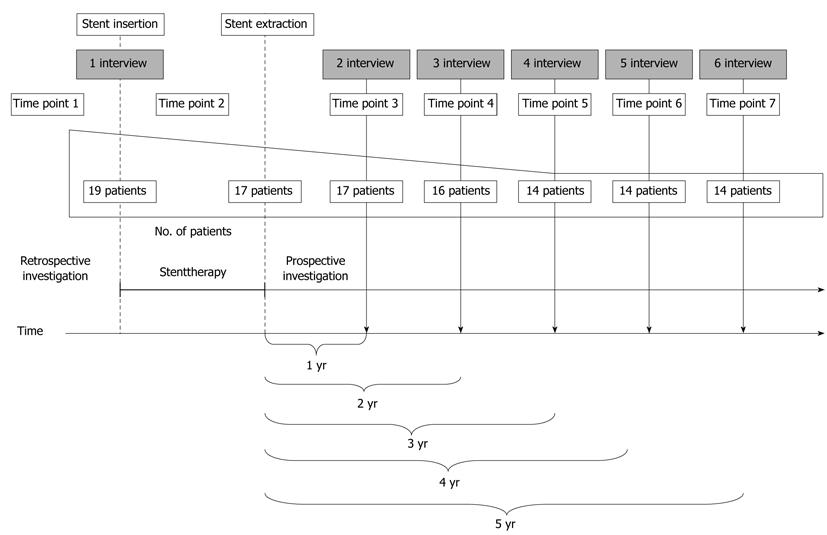Copyright
©2013 Baishideng Publishing Group Co.
World J Gastroenterol. Feb 7, 2013; 19(5): 715-720
Published online Feb 7, 2013. doi: 10.3748/wjg.v19.i5.715
Published online Feb 7, 2013. doi: 10.3748/wjg.v19.i5.715
Figure 1 Protocol of the current study, time points of investigation and examination.
Nineteen patients with chronic obstructive pancreatitis underwent endoscopic stent therapy. Endoscopic therapy failed in 2 patients. Seventeen of 19 patients showed clinical benefit and were included to follow-up analysis after completion of stent therapy. During the follow-up, patients were interviewed yearly. Three patients were lost to follow-up. One patient was not available any longer and two patients died.
Figure 2 Illustration of a representative endoscopic retrograde pancreatography procedure.
A: A dilated pancreatic duct due to a stenosis in the head and several stones in the main duct (A1). The stenosis was passed through with a 5 F catheter followed by a 8.5 F Sohendra Bougie. Subsequently, a 7 F stent was inserted (A2). After initial endoscopic intervention the patient was completely pain free; B: Four weeks later, the patient was readmitted for control endoscopic retrograde pancreatography (ERP). Stones were partially extracted by a dormia basket (B1), and the 7 F stent was replaced by a 10 F stent (B2); C: Three months later, the patient was still free of complaints. ERP revealed a slightly dilated duct with typical stone formations in the corpus and tail of the pancreas. Stones were extracted.
- Citation: Weber A, Schneider J, Neu B, Meining A, Born P, von Delius S, Bajbouj M, Schmid RM, Algül H, Prinz C. Endoscopic stent therapy in patients with chronic pancreatitis: A 5-year follow-up study. World J Gastroenterol 2013; 19(5): 715-720
- URL: https://www.wjgnet.com/1007-9327/full/v19/i5/715.htm
- DOI: https://dx.doi.org/10.3748/wjg.v19.i5.715










